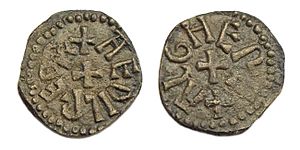Styca facts for kids
The styca was a small coin used a long, long time ago in a part of England called Northumbria. This was before the Vikings took over. Stycas were first made from a mix of silver, but later they were mostly made from a copper metal. People started making them in the 790s and continued until the 850s. Even after they stopped making new ones, people still used stycas until the Vikings conquered Northumbria in 867.
Contents
What's in a Name?
The name "styca" comes from an old English word, styċċe. This word simply meant "piece." So, a styca was just a "piece" of money!
The History of Styca Coins
When Were Stycas First Made?

Stycas first appeared when Æthelred I of Northumbria was king (from 790 to 796). They replaced an older coin called the sceat, which stopped being made around 790.
What Were Stycas Made Of?
At first, stycas were made from a mix of silver that wasn't very pure. Around 830, they also started making them from a copper metal. By 837, almost all stycas were made entirely of copper. This continued until about 855.
Why Did Styca Production Stop?
Even though new stycas stopped being made around 855, people kept using them until the Vikings took over Northumbria in 867. Stycas were special because they were only used in Northumbria. Other Anglo-Saxon kingdoms in England used silver pennies, which were similar to coins from France.
Many copper stycas have been found, which tells us that a lot of them were made very quickly from the 830s onwards. Also, many stycas were not made officially. This might be one reason why they stopped making them during the time of King Osberht of Northumbria.
How Stycas Looked
Most styca coins looked quite similar. One side usually had the name of the king or archbishop who issued the coin, with a simple design in the middle. The other side had the name of the person who made the coin, called a moneyer.
Common designs in the middle included simple cross shapes or circles of small dots. However, some stycas were different! For example, coins made by a moneyer named Leofdegn during the reign of Æthelred II of Northumbria had more detailed designs. Some even featured a dog and a special three-cornered knot design called a triquetra.
Where Stycas Have Been Found
Many styca coins have been found in groups called "hoards." These are like hidden treasures of coins! Some famous hoards that include stycas are:
- Hexham Hoard
- Kirkoswald Hoard
- St Leonard's Place hoard
- Talnotrie Hoard
See also
- Elizabeth Pirie
- Wigmund (archbishop of York)

